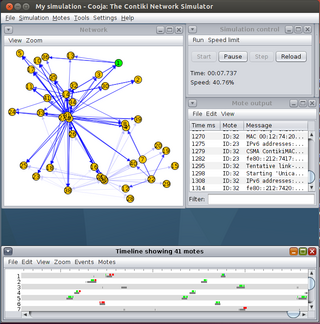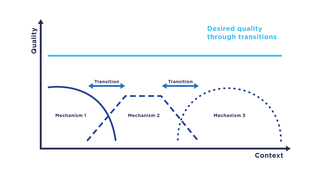A web service (WS) is either:
Message-oriented middleware (MOM) is software or hardware infrastructure supporting sending and receiving messages between distributed systems. Message-oriented middleware is in contrast to streaming-oriented middleware where data is communicated as a sequence of bytes with no explicit message boundaries. Note that streaming protocols are almost always built above protocols using discrete messages such as frames (Ethernet), datagrams (UDP), packets (IP), cells (ATM), et al.

Contiki is an operating system for networked, memory-constrained systems with a focus on low-power wireless Internet of Things (IoT) devices. Contiki is used for systems for street lighting, sound monitoring for smart cities, radiation monitoring and alarms. It is open-source software released under the BSD-3-Clause license.
REST is a software architectural style that was created to guide the design and development of the architecture for the World Wide Web. REST defines a set of constraints for how the architecture of a distributed, Internet-scale hypermedia system, such as the Web, should behave. The REST architectural style emphasises uniform interfaces, independent deployment of components, the scalability of interactions between them, and creating a layered architecture to promote caching to reduce user-perceived latency, enforce security, and encapsulate legacy systems.
AUTOSAR is a global development partnership founded in 2003 by automotive manufacturers, suppliers and other companies from the electronics, semiconductor and software industries. Its purpose is to develop and establish an open and standardized software architecture for automotive electronic control units (ECUs).

Profinet is an industry technical standard for data communication over Industrial Ethernet, designed for collecting data from, and controlling equipment in industrial systems, with a particular strength in delivering data under tight time constraints. The standard is maintained and supported by Profibus and Profinet International, an umbrella organization headquartered in Karlsruhe, Germany.
A network socket is a software structure within a network node of a computer network that serves as an endpoint for sending and receiving data across the network. The structure and properties of a socket are defined by an application programming interface (API) for the networking architecture. Sockets are created only during the lifetime of a process of an application running in the node.

Apache Axis2 is a web service engine. It is a redesign and re-write of the widely used Apache Axis SOAP stack. Implementations of Axis2 are available in Java and C.

A computer appliance is a computer system with a combination of hardware, software, or firmware that is specifically designed to provide a particular computing resource. Such devices became known as appliances because of the similarity in role or management to a home appliance, which are generally closed and sealed, and are not serviceable by the user or owner. The hardware and software are delivered as an integrated product and may even be pre-configured before delivery to a customer, to provide a turn-key solution for a particular application. Unlike general purpose computers, appliances are generally not designed to allow the customers to change the software and the underlying operating system, or to flexibly reconfigure the hardware.
Carrier Ethernet is a marketing term for extensions to Ethernet for communications service providers that utilize Ethernet technology in their networks.
Web of Things (WoT) describes a set of standards by the World Wide Web Consortium (W3C) for the interoperability of different Internet of things platforms and application domains.
Software-defined networking (SDN) is an approach to network management that uses abstraction to enable dynamic and programmatically efficient network configuration to create grouping and segmentation while improving network performance and monitoring in a manner more akin to cloud computing than to traditional network management. SDN is meant to improve the static architecture of traditional networks and may be employed to centralize network intelligence in one network component by disassociating the forwarding process of network packets from the routing process. The control plane consists of one or more controllers, which are considered the brains of the SDN network, where the whole intelligence is incorporated. However, centralization has certain drawbacks related to security, scalability and elasticity.
The Open Smart Grid Protocol (OSGP) is a family of specifications published by the European Telecommunications Standards Institute (ETSI) used in conjunction with the ISO/IEC 14908 control networking standard for smart grid applications. OSGP is optimized to provide reliable and efficient delivery of command and control information for smart meters, direct load control modules, solar panels, gateways, and other smart grid devices. With over 5 million OSGP based smart meters and devices deployed worldwide it is one of the most widely used smart meter and smart grid device networking standards.
RTP-MIDI is a protocol to transport MIDI messages within Real-time Transport Protocol (RTP) packets over Ethernet and WiFi networks. It is completely open and free, and is compatible both with LAN and WAN application fields. Compared to MIDI 1.0, RTP-MIDI includes new features like session management, device synchronization and detection of lost packets, with automatic regeneration of lost data. RTP-MIDI is compatible with real-time applications, and supports sample-accurate synchronization for each MIDI message.
Software-defined storage (SDS) is a marketing term for computer data storage software for policy-based provisioning and management of data storage independent of the underlying hardware. Software-defined storage typically includes a form of storage virtualization to separate the storage hardware from the software that manages it. The software enabling a software-defined storage environment may also provide policy management for features such as data deduplication, replication, thin provisioning, snapshots and backup.
Network functions virtualization (NFV) is a network architecture concept that leverages IT virtualization technologies to virtualize entire classes of network node functions into building blocks that may connect, or chain together, to create and deliver communication services.

Open vSwitch (OVS) is an open-source implementation of a distributed virtual multilayer switch. The main purpose of Open vSwitch is to provide a switching stack for hardware virtualization environments, while supporting multiple protocols and standards used in computer networks.

RIOT is a small operating system for networked, memory-constrained systems with a focus on low-power wireless Internet of things (IoT) devices. It is open-source software, released under the GNU Lesser General Public License (LGPL).
In software engineering, a microservice architecture is an architectural pattern that arranges an application as a collection of loosely coupled, fine-grained services, communicating through lightweight protocols. A microservice-based architecture enables teams to develop and deploy their services independently, reduce code interdependency and increase readability and modularity within a codebase. This is achieved by reducing several dependencies in the codebase, allowing developers to evolve their services with limited restrictions, and reducing additional complexity. Consequently, organizations can develop software with rapid growth and scalability, as well as implement off-the-shelf services more easily. These benefits come with the cost of needing to maintain a decoupled structure within the codebase, which means its initial implementation is more complex than that of a monolithic codebase. Interfaces need to be designed carefully and treated as APIs.

Transition refers to a computer science paradigm in the context of communication systems which describes the change of communication mechanisms, i.e., functions of a communication system, in particular, service and protocol components. In a transition, communication mechanisms within a system are replaced by functionally comparable mechanisms with the aim to ensure the highest possible quality, e.g., as captured by the quality of service.







